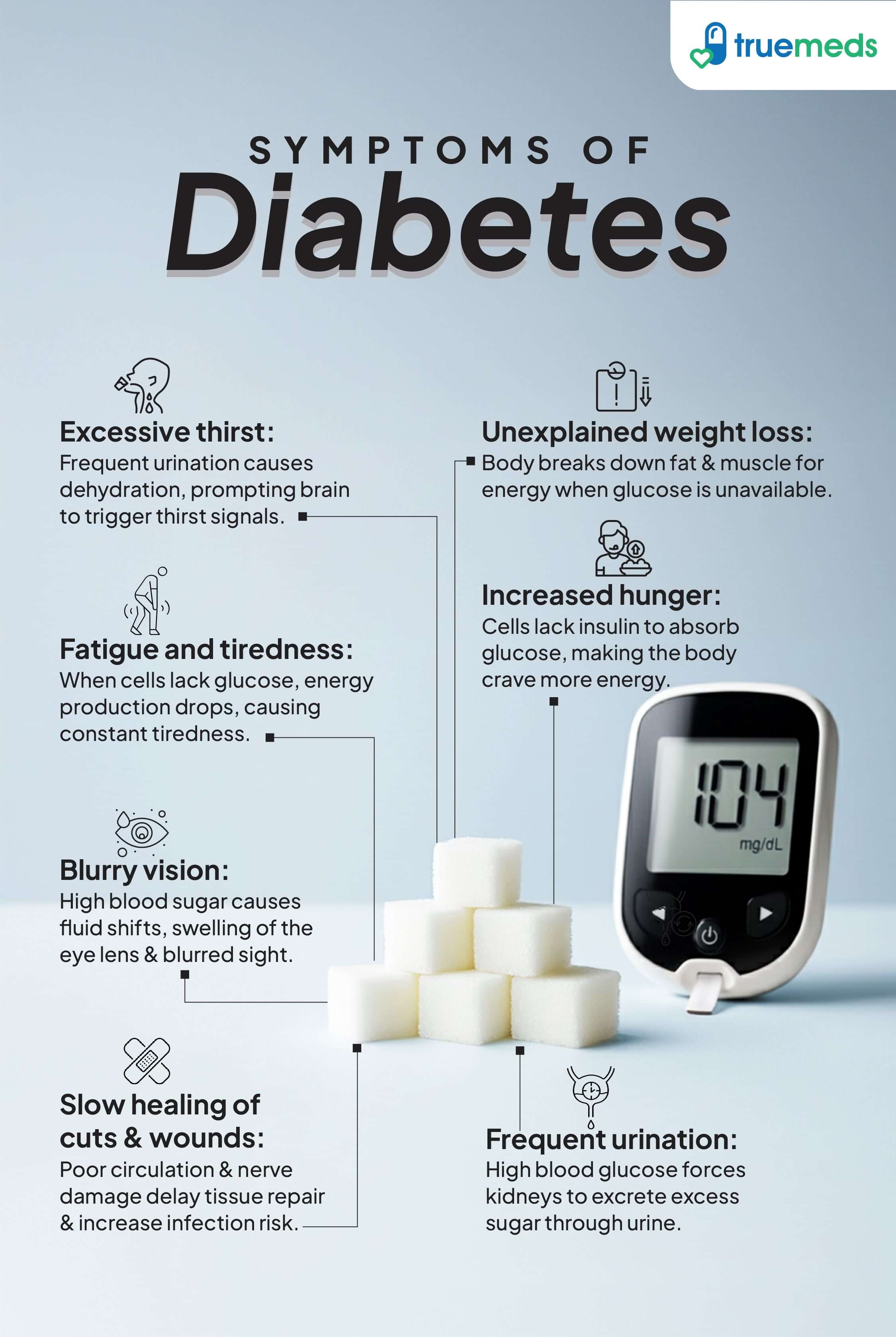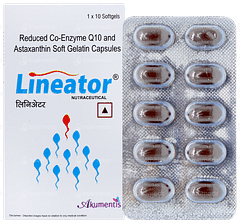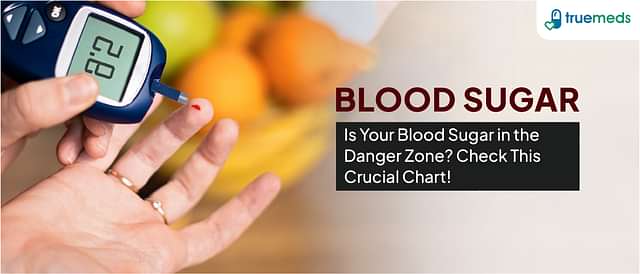Diabetes Mellitus
Diabetes mellitus commonly known as Diabetes is a chronic metabolic disorder characterised by elevated blood glucose levels due to insufficient insulin production or resistance to insulin action. It can lead to severe complications if left untreated and is classified into three main types: type 1, type 2, and gestational diabetes. Proper management through lifestyle changes, medication, and regular monitoring is crucial for preventing complications and maintaining overall health.
Last updated on : 20 Nov, 2025
Read time : 16 mins

Overview of Diabetes Mellitus
Diabetes mellitus is a prevalent chronic disease that affects millions of people worldwide. It is a metabolic disorder that occurs when the body cannot produce enough insulin or effectively use the insulin it produces, leading to high blood glucose levels. Over time, uncontrolled diabetes can cause serious damage to various organs, including the heart, blood vessels, eyes, kidneys, and nerves. Understanding the causes, symptoms, and management of diabetes is crucial for maintaining optimal health and preventing complications.
What is Diabetes Mellitus?
Diabetes mellitus also known as Diabetes is a disorder of carbohydrate metabolism characterised by abnormally high blood sugar (glucose) levels. In a healthy individual, the pancreas produces insulin, a hormone that helps glucose enter cells to be used for energy. However, in people with diabetes, either the pancreas does not produce enough insulin, or the body's cells do not respond normally to insulin, leading to a buildup of glucose in the blood. This results in symptoms such as increased urination, thirst, weight loss, and potential damage to nerves and blood vessels.
Key Factors about Diabetes Mellitus
| Category | Details |
| Also Referred as | Insulin-dependent diabetes, Juvenile-onset diabetes, Non-insulin-dependent diabetes, Adult-onset diabetes |
| Commonly Occurs In | Children, adolescents, middle-aged adults, older adults |
| Affected Organ | Pancreas, liver, fat, muscle cells |
| Type | Type 1 Diabetes Mellitus, Type 2 Diabetes Mellitus |
| Common Signs | Increased urination, thirst, blurry vision, fatigue, unexplained weight loss, slow healing of cuts |
| Consulting Specialist | Endocrinologist |
| Treatement Procedures | Insulin injections, monitoring blood sugar levels, lifestyle changes, medications |
| Managed By | Insulin, metformin, glimepiride |
| Mimiciking Condition | Diabetes insipidus |
Types of Diabetes Mellitus
Here are the different types of the condition:
Type 1 Diabetes Mellitus
Type 1 Diabetes, also known as insulin-dependent diabetes, is an autoimmune disease in which the body's immune system attacks and destroys the insulin-producing beta cells in the pancreas. As a result, little or no insulin is produced, leading to high blood sugar levels. Type 1 diabetes usually develops in childhood or adolescence but can also occur in adults. People with type 1 diabetes require daily insulin injections or the use of an insulin pump to manage their blood sugar levels.
Type 2 Diabetes Mellitus
Type 2 Diabetes is the most common form of diabetes, accounting for around 90% of all cases. In type 2 diabetes, the body's cells become less responsive to insulin, a condition known as insulin resistance. As a result, glucose builds up in the blood, and the pancreas produces more insulin to compensate. Over time, the pancreas may not be able to produce enough insulin to maintain normal blood sugar levels. Type 2 diabetes typically develops in middle or late adulthood but is increasingly being diagnosed in children and adolescents due to rising obesity rates. Risk factors for type 2 diabetes include obesity, physical inactivity, family history, and certain ethnicities.
Gestational Diabetes Mellitus
Gestational Diabetes is a type of diabetes that develops during pregnancy, usually in the second or third trimester. It occurs when hormonal changes and insulin resistance during pregnancy affect the body's ability to process glucose effectively. While gestational diabetes typically resolves after childbirth, women who experience it are at a higher risk of developing type 2 diabetes later in life. Proper management of gestational diabetes through diet, exercise, and sometimes medication is essential for the health of both the mother and the baby.
Early Signs of Diabetes Mellitus
Being aware of the following early signs can help in the timely diagnosis and management of diabetes mellitus:
Frequent urination
Excessive thirst and dry mouth
Increased hunger
Fatigue and tiredness
Unexplained weight loss
Blurry vision
Slow healing cuts and wounds
Tingling or numbness in hands and feet
Dark, velvety skin patches, particularly in the folds of the neck, armpits, or groin
Frequent yeast infections
Dry skin
Symptoms of Diabetes Mellitus
Recognising the following symptoms is crucial for the early detection and treatment of diabetes mellitus:

Common Symptoms
The symptoms of diabetes mellitus can be subtle and may develop gradually, making them easy to overlook. The most common symptoms include increased thirst, frequent urination, excessive hunger, fatigue, and unexplained weight loss. High blood sugar levels can cause the kidneys to work harder to remove excess sugar from the blood, leading to frequent urination and dehydration. This, in turn, can cause excessive thirst. Since the body's cells cannot absorb glucose properly, individuals may feel constantly hungry despite eating regularly.
Vision and Healing Issues
High blood sugar can damage blood vessels in the eyes, leading to blurry vision. Additionally, it can impair blood circulation and nerve function, causing slow healing of cuts and wounds, as well as tingling or numbness in the hands and feet.
Skin and Infection Problems
Excess sugar in the urine can lead to frequent yeast infections, particularly in warm, moist areas of the skin. Dark, velvety skin patches called acanthosis nigricans can form in the folds of the neck, armpits, or groin due to an excess of insulin in the blood.
Stages of Diabetes Mellitus
Diabetes mellitus has the following stages:
Prediabetes
Prediabetes is a condition in which blood sugar levels are higher than normal but not high enough to be classified as diabetes. People with prediabetes are at increased risk of developing type 2 diabetes if left untreated. Making lifestyle changes, such as adopting a healthy diet and increasing physical activity, can help prevent or delay the progression to type 2 diabetes.
Diabetes
When blood sugar levels remain consistently elevated, a person is diagnosed with diabetes. At this stage, proper management through lifestyle modifications, medication, and regular monitoring is essential to control blood sugar levels and prevent complications.
Complications of Diabetes
Uncontrolled diabetes can lead to serious complications over time. These include cardiovascular disease, such as heart attack and stroke, chronic kidney disease, vision loss due to diabetic retinopathy, and nerve damage (neuropathy). Regular check-ups and adherence to treatment plans can help minimise the risk of developing these complications.
Causes of Diabetes Mellitus
Diabetes mellitus might have different causes:
Type 1 and Type 2 Diabetes
Diabetes mellitus is primarily caused by issues with insulin production or usage. Type 1 diabetes occurs when the body does not produce enough insulin, while Type 2 diabetes happens when the body does not respond properly to insulin (insulin resistance). Both types lead to high blood sugar levels.
Gestational Diabetes
Gestational diabetes is a form of diabetes that develops during pregnancy, often due to hormonal changes and increased insulin resistance.
Risk Factors of Diabetes Mellitus
There are different risk factors for diabetes mellitus:
Family history of diabetes
Being overweight or obese
Physical inactivity
High blood pressure
High cholesterol levels
Prediabetes (elevated blood sugar levels, but not high enough for a diabetes diagnosis)
Polycystic ovary syndrome (PCOS)
Age (risk increases with age, particularly after 45 years)
Ethnicity (higher risk among African Americans, Hispanics, Native Americans, and Asian Americans)
Who's at Risk?
Lifestyle factors such as being overweight, having a sedentary lifestyle, and consuming a diet high in processed foods and added sugars can increase the risk of developing type 2 diabetes mellitus. If you identify with any of these risk factors and develop any symptoms associated with diabetes mellitus, please check with your doctor for a diagnosis.
Complications
People with diabetes mellitus may develop the following complications:
Heart and Blood Vessel Complications
Diabetes mellitus significantly increases the risk of developing cardiovascular diseases, such as coronary artery disease, heart attacks, strokes, and atherosclerosis. These conditions can lead to angina, heart failure, and narrowing of arteries, which can have severe consequences for an individual's health and quality of life.
Nerve Damage (Diabetic Neuropathy)
Persistently high blood sugar levels can damage nerves, causing symptoms like numbness, tingling, burning, or pain in the hands, feet, or legs. This nerve damage, known as diabetic neuropathy, can also affect digestive nerves, leading to nausea, vomiting, diarrhoea, or constipation. In some cases, it may even result in erectile dysfunction.
Kidney Damage (Diabetic Nephropathy)
Over time, diabetes can damage the kidneys' filtering system, causing a condition called diabetic nephropathy. If left untreated, this can progress to chronic kidney disease, potentially requiring dialysis or a kidney transplant.
Eye Damage (Diabetic Retinopathy)
Elevated blood sugar levels can damage the blood vessels in the eyes, increasing the risk of developing eye diseases such as glaucoma, cataracts, and diabetic retinopathy. If not properly managed, these conditions can lead to vision loss or even blindness.
Foot Damage
The combination of nerve and blood vessel damage caused by diabetes can result in numbness, tingling, pain, or loss of feeling in the feet. This makes it more difficult for individuals to notice minor cuts and blisters, which can develop into ulcers, infections, and, in severe cases, may require amputations.
Other Complications
Diabetes mellitus can also lead to various other complications, including skin and mouth conditions, hearing impairment, Alzheimer's disease, dementia, digestion problems, increased susceptibility to infections, dental problems, osteoporosis, myopathy, and depression. Managing blood sugar levels effectively is crucial in preventing or delaying the onset of these complications.
Prevention of Diabetes Mellitus
Here are some preventative measures you can follow, especially if you have diabetes mellitus risk:
Maintain a Healthy Weight
One of the most important steps in preventing diabetes is maintaining a healthy weight. Being overweight or obese is a significant risk factor for developing type 2 diabetes. Aim to achieve and maintain a body mass index (BMI) within the healthy range by following a balanced diet and engaging in regular physical activity.
Engage in Regular Physical Activity
Regular exercise helps control weight, lower blood sugar levels, and increase insulin sensitivity. Aim for at least 150 minutes of moderate-intensity aerobic activity or 75 minutes of vigorous-intensity aerobic activity per week, along with strength training exercises at least twice a week.
Follow a Balanced Diet
Eat a variety of nutrient-dense foods, such as fruits, vegetables, whole grains, lean proteins, and healthy fats. Limit your intake of saturated and trans fats, added sugars, and processed foods. Focus on consuming foods with a low glycemic index to help maintain stable blood sugar levels.
Manage Stress
Chronic stress can lead to elevated blood sugar levels. Engage in stress-reducing activities like meditation, deep breathing exercises, yoga, or hobbies you enjoy to help manage stress effectively.
Avoid Smoking and Limit Alcohol Consumption
Smoking and excessive alcohol consumption can increase the risk of developing diabetes and its complications. If you smoke, seek help to quit, and limit your alcohol intake to moderate levels, if at all.
Regular Check-ups
Schedule regular check-ups with your healthcare provider to monitor your blood sugar, blood pressure, and cholesterol levels. Early detection and management of pre-diabetes or diabetes can help prevent or delay the onset of complications.
Diagnosis & Tests
To diagnose diabetes mellitus, your doctor might perform several steps, including:
Fasting Plasma Glucose (FPG) Test
The fasting plasma glucose test measures blood sugar levels after an 8-hour fast. A result of 126 mg/dL (7.0 mmol/L) or higher on two separate tests indicates diabetes.
Oral Glucose Tolerance Test (OGTT)
The oral glucose tolerance test involves measuring blood sugar levels before and 2 hours after drinking a glucose-containing liquid. A result of 200 mg/dL (11.1 mmol/L) or higher suggests diabetes.
Random Plasma Glucose (RPG) Test
The random plasma glucose test measures blood sugar levels at any time, regardless of when you last ate. A result of 200 mg/dL (11.1 mmol/L) or higher, along with symptoms of diabetes, indicates diabetes.
Glycated Hemoglobin (HbA1c) Test
The HbA1c test measures your average blood sugar levels over the past 2-3 months. An HbA1c level of 6.5% or higher on two separate tests indicates diabetes. Normal HbA1c levels are below 5.7%, while levels between 5.7% and 6.4% suggest pre-diabetes.
Treatment & Management
Treatment typically involves a combination of lifestyle changes, oral or injectable medications, and regular monitoring.
1. Lifestyle Modifications
The cornerstone of diabetes management begins with:
- Balanced diet (low glycemic index, high fibre, controlled carbs)
- Regular physical activity (e.g., 150 minutes of moderate exercise/week)
- Weight management
- Smoking cessation
- Alcohol moderation
- Stress management techniques (e.g., meditation, yoga, therapy)
2. Oral Medications
If lifestyle changes alone are not sufficient, oral antidiabetic agents are initiated, especially in Type 2 Diabetes Mellitus.
a. Biguanides
- Metformin: First-line treatment. Decreases hepatic glucose production and improves insulin sensitivity.
b. Sulfonylureas
- Glimepiride, Glipizide, Glyburide (Glibenclamide): Stimulate pancreatic insulin secretion.
c. Meglitinides (Glinides)
- Repaglinide, Nateglinide: Stimulate rapid, short-term insulin release; useful for postprandial glucose control.
d. Thiazolidinediones (TZDs)
- Pioglitazone, Rosiglitazone: Improve insulin sensitivity in muscle and adipose tissue.
e. Alpha-Glucosidase Inhibitors
- Acarbose, Miglitol: Delay carbohydrate digestion and absorption in the intestine.
f. DPP-4 Inhibitors (Gliptins)
- Sitagliptin, Saxagliptin, Linagliptin, Vildagliptin, Alogliptin: Increase incretin levels to stimulate insulin secretion and suppress glucagon.
g. SGLT2 Inhibitors
- Canagliflozin, Dapagliflozin, Empagliflozin, Ertugliflozin: Reduce glucose reabsorption in kidneys, promoting glucose excretion in urine.
h. Bile Acid Sequestrants
- Colesevelam: Lowers blood glucose through unclear mechanisms; also improves lipid profile.
i. Dopamine Agonists
- Bromocriptine (quick-release): Affects circadian rhythm and insulin sensitivity.
3. Adjunct Therapies & Monitoring
- Antihypertensives (e.g., ACE inhibitors, ARBs): For blood pressure control and renal protection.
- Lipid-lowering agents (e.g., statins): To reduce cardiovascular risk.
- Low-dose aspirin – May be prescribed for secondary cardiovascular prevention.
- Regular monitoring:
- HbA1c every 3–6 months
- Fasting and postprandial blood sugar
- Blood pressure, cholesterol, kidney function, and foot examination
When to See a Doctor?
If you experience any symptoms of diabetes mellitus, such as frequent urination, excessive thirst, unexplained weight loss, blurred vision, or slow-healing wounds, it's essential to consult with a doctor promptly. Early diagnosis and treatment can help prevent or delay the onset of complications associated with diabetes mellitus.
Additionally, if you have been diagnosed with diabetes mellitus and are experiencing difficulty managing your blood sugar levels or are concerned about potential complications, it's crucial to maintain regular check-ups with your healthcare provider. They can help adjust your treatment plan, monitor your condition, and provide guidance on lifestyle changes to optimise your health.
Key Takeaways
Diabetes mellitus is a chronic condition characterised by elevated blood sugar levels due to either a lack of insulin production (Type 1) or insulin resistance (Type 2).
Common symptoms of diabetes mellitus include frequent urination, excessive thirst, unexplained weight loss, blurred vision, and slow-healing wounds.
Risk factors for developing diabetes mellitus include family history, obesity, physical inactivity, and age.
Diagnosis of diabetes mellitus involves blood tests such as the fasting plasma glucose test, oral glucose tolerance test, and glycated haemoglobin (A1C) test.
Treatment for diabetes mellitus includes lifestyle changes (diet and exercise), blood sugar monitoring, and medications such as metformin, sulfonylureas, and insulin therapy.
Regular check-ups with a healthcare provider are essential for managing diabetes mellitus and preventing complications.
FAQs
What is the most effective approach to manage type 2 diabetes?
The best way to control type 2 diabetes is through a combination of weight management, a balanced diet, regular exercise, stress reduction, and medication or insulin if needed.
Can individuals with type 2 diabetes have a normal lifestyle?
Yes, with proper management through a healthy diet, regular physical activity, blood sugar monitoring, and adherence to prescribed treatments, people with type 2 diabetes can lead normal, active lives.
Is there a cure for type 2 diabetes?
Currently, there is no known cure for type 2 diabetes. However, significant weight loss and lifestyle changes may lead to remission, where blood sugar levels return to normal without medication, especially in the early stages.
How serious is type 2 diabetes?
Type 2 diabetes is a serious condition that can cause various complications, such as heart disease, stroke, blindness, nerve damage, and kidney failure, if not properly managed through regular monitoring and treatment adherence.
What foods should people with diabetes avoid consuming?
Diabetics should limit or avoid processed foods high in added sugars, salt, and unhealthy fats, sugary drinks like soda and fruit juices, refined carbohydrates such as white bread and pasta, and high-fat animal products.
Can Ayurveda cure diabetes?
While Ayurvedic treatments may help manage diabetes symptoms, there is no scientific evidence to suggest that Ayurveda can cure diabetes. It is essential to consult with a licensed medical professional for proper diabetes management.
How does the disease process of diabetes mellitus occur?
Diabetes mellitus occurs when the body cannot effectively use or produce insulin, leading to high blood sugar levels. In type 2 diabetes, the body becomes resistant to insulin or doesn't produce enough insulin.
What is the difference between diabetes mellitus and diabetes?
What are the 4 types of diabetes?
Do type 2 diabetics take insulin?
What are 10 warning signs of diabetes?
References
American Diabetes Association. (2021). 2. Classification and diagnosis of diabetes: Standards of medical care in diabetes—2021. Diabetes Care, 44(Supplement 1), S15-S33. https://doi.org/10.2337/dc21-S002
Centers for Disease Control and Prevention. (2020, June 11). What is diabetes? https://www.cdc.gov/diabetes/basics/diabetes.html
Galicia-Garcia, U., Benito-Vicente, A., Jebari, S., Larrea-Sebal, A., Siddiqi, H., Uribe, K. B., Ostolaza, H., & Martín, C. (2020). Pathophysiology of type 2 diabetes mellitus. International Journal of Molecular Sciences, 21(17), 6275. https://doi.org/10.3390/ijms21176275
National Institute of Diabetes and Digestive and Kidney Diseases. (2016, December). Diabetes overview. https://www.niddk.nih.gov/health-information/diabetes/overview
World Health Organization. (2020, June 8). Diabetes. https://www.who.int/news-room/fact-sheets/detail/diabetes
Lancet study: More than 100 million people in India diabetic. (2023, June 9). BBC Breaking News, World News, US News, Sports, Business, Innovation, Climate, Culture, Travel, Video & Audio. https://www.bbc.com/news/world-asia-india-65852551
Browse Other Conditions
Latest health articles
Top Health Essentials




















Disclaimer
Top-Selling Medicines:
...View more
Top-OTC medicines:
...View more
Company
About UsHealth ArticleHealth StoriesHealth LibraryDiseases & Health ConditionsAyurvedaUnderstanding Generic MedicinesAll MedicinesAll BrandsNeed HelpFAQSecuritySubscribe
Registered Office Address
Grievance Officer
Download Truemeds
Contact Us
Our customer representative team is available 7 days a week from 9 am - 9 pm.
v4.11.1
2026 - Truemeds | All rights reserved. Our content is for informational purposes only. See additional information.
Our Payment Partners




































